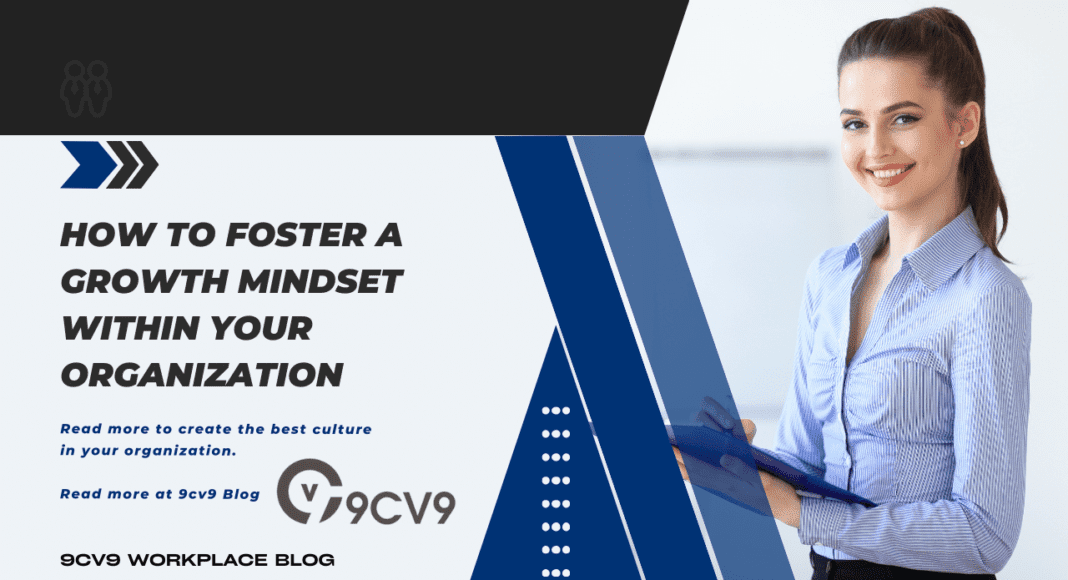Key Takeaways
- Cultivate a Growth-Oriented Culture: Foster an environment that encourages continuous learning, embraces challenges, and views failures as opportunities for improvement.
- Lead by Example: Demonstrate a growth mindset as leaders, encouraging employees to take risks, seek development, and learn from setbacks.
- Measure Progress and Adapt: Track key performance indicators, overcome challenges, and consistently communicate the organization’s commitment to growth mindset principles for sustained success.
Welcome to our comprehensive guide on fostering a growth mindset within your organization.
In today’s fast-paced and ever-evolving business landscape, the concept of a growth mindset has emerged as a powerful force driving success, innovation, and resilience.
Embracing a growth mindset can not only transform individual employees but also revolutionize the entire organizational culture, fostering an environment where learning, adaptability, and progress thrive.
As an ambitious leader or HR professional, you understand that your organization’s greatest asset lies in its people.
Nurturing a growth mindset among your employees is not just a fleeting trend; it’s a strategic imperative for building a robust and future-ready workforce.
In this informative blog, we will dive deep into the core principles of a growth mindset, explore its profound impact on workplace dynamics, and equip you with actionable strategies to instill this transformative mindset throughout your organization.
Before we embark on this journey of cultivating a growth mindset within your organization, it’s essential to grasp the foundational principles that underpin this concept.
Coined by renowned psychologist Carol Dweck, a growth mindset refers to the belief that abilities and intelligence can be developed through dedication, effort, and learning.
In contrast, a fixed mindset assumes that talents and abilities are fixed traits, leading individuals to shy away from challenges and recoil in the face of failures.
In this section, we’ll delve into the stark differences between a growth mindset and a fixed mindset, exploring the incredible benefits of cultivating the former in the workplace.
We’ll also explore the pivotal role leadership plays in championing this mindset and empowering employees to unleash their true potential.
Like any transformative endeavor, it’s crucial to evaluate your organization’s existing mindset before embarking on a journey of change.
Conducting a mindset audit will help identify any prevalent fixed mindset tendencies and reveal potential barriers to cultivating a growth-oriented culture.
By taking a close look at the organization’s values, communication patterns, employee attitudes, and performance metrics, you can gain valuable insights into the prevailing mindset.
Additionally, collecting candid feedback from employees and stakeholders will offer valuable perspectives, paving the way for a targeted and effective growth mindset implementation strategy.
In this section, we transition from understanding to action, outlining a series of practical and result-oriented strategies to foster a growth mindset culture.
Creating a safe and supportive environment is paramount, where employees are encouraged to take calculated risks and embrace failures as stepping stones to progress.
We’ll explore how emphasizing effort and the learning process over outcomes can fuel motivation and resilience among your workforce.
Moreover, we’ll dive into the significance of cultivating a learning culture, where continuous learning and knowledge sharing are celebrated and ingrained into the organization’s fabric.
By providing employees with access to diverse learning opportunities and promoting collaborative initiatives, you can stimulate a growth-oriented mindset that propels your organization to new heights.
To truly foster a growth mindset, employees must feel empowered and equipped to navigate their professional journeys.
Setting clear and realistic goals aligned with the organization’s vision is pivotal to ensuring employees have a sense of direction and purpose.
Regular feedback and coaching sessions will provide them with the necessary support and guidance to overcome challenges and enhance their skill sets continually.
Additionally, investing in skill development and training programs demonstrates a commitment to individual growth, fostering loyalty and a sense of fulfillment among your team members.
As the driving force behind organizational culture, leadership plays a central role in nurturing a growth mindset.
In this segment, we will explore how leaders can lead by example, embodying the principles of a growth mindset in their actions and decisions.
By openly embracing challenges, learning from failures, and seeking opportunities for personal and professional development, leaders can set a powerful precedent for their teams.
We’ll also discuss the criticality of effective communication, as leaders advocate for a growth-oriented culture and inspire employees to overcome self-limiting beliefs.
Furthermore, fostering mentorship and guidance within the organization can foster a supportive ecosystem where knowledge and experience are shared organically.
Measuring and Tracking Progress: In this data-driven era, measuring the impact of any cultural transformation is essential for refining and optimizing strategies.
Identifying key performance indicators (KPIs) related to a growth mindset will enable you to track progress, gauge employee engagement, and assess the overall efficacy of your implementation efforts.
By analyzing data and gathering valuable insights, you can make data-driven decisions, fine-tune your approach, and ensure the sustainability of a growth mindset culture over the long term.
As you reach the end of this comprehensive guide, you are now equipped with the knowledge and tools to foster a growth mindset within your organization successfully.
Embracing a growth mindset is not an overnight process, but with persistence and dedication, you can cultivate a culture of continuous learning, resilience, and innovation.
By instilling a growth mindset in your workforce, you are investing in the organization’s future, nurturing an agile and adaptable team that can navigate the uncertainties of the modern business landscape with confidence.
Remember, the journey to a growth mindset begins with a single step, and your commitment to this transformative endeavor will undoubtedly yield remarkable results for your organization and its most valuable asset—your people.
So, take that step today and unlock the true potential within your organization.
Before we venture further into this article, we like to share who we are and what we do.
About 9cv9
9cv9 is a business tech startup based in Singapore and Asia, with a strong presence all over the world.
With over six years of startup and business experience, and being highly involved in connecting with thousands of companies and startups, the 9cv9 team has listed some important learning points in this overview of the guide on How to Foster a Growth Mindset within Your Organization.
If your company needs recruitment and headhunting services to hire top-quality employees, you can use 9cv9 headhunting and recruitment services to hire top talents and candidates. Find out more here, or send over an email to [email protected].
Or just post 1 free job posting here at 9cv9 Hiring Portal in under 10 minutes.
How to Foster a Growth Mindset within Your Organization
- Understanding the Principles of a Growth Mindset
- Assessing Your Organization’s Current Mindset
- Strategies to Foster a Growth Mindset Culture
- Empowering Employees for Growth
- Leading by Example: Role of Leadership
- Measuring and Tracking Progress
- Overcoming Challenges in Implementing a Growth Mindset
1. Understanding the Principles of a Growth Mindset

In today’s highly competitive and rapidly changing business landscape, understanding and embracing the principles of a growth mindset have become imperative for organizations seeking sustained success and innovation.
Coined by the influential psychologist, Carol Dweck, a growth mindset is a belief that abilities, intelligence, and talents can be developed and improved through dedication, effort, and a willingness to learn.
In contrast, a fixed mindset holds the belief that these traits are fixed and immutable, leading individuals to avoid challenges and shy away from opportunities for growth.
- The Contrast Between Growth Mindset and Fixed Mindset:
1.1 Growth Mindset: A growth mindset fosters a desire for learning and embraces challenges as opportunities for growth. Individuals with a growth mindset view failures as stepping stones to success, learning from them, and using setbacks as a catalyst to improve and evolve. They persist in the face of obstacles, continually seeking to expand their knowledge and skills. This mindset is a driving force behind innovation and creativity, as it encourages employees to think outside the box and explore new approaches to problem-solving.
Example: A software development team encounters a challenging coding problem while working on a new application. Instead of getting discouraged, team members with a growth mindset collaborate, conduct research, and seek mentorship to find a solution. They perceive the obstacle as a chance to deepen their coding expertise and enhance the quality of their work.
1.2 Fixed Mindset: On the other hand, individuals with a fixed mindset tend to avoid challenges and may feel threatened by the prospect of failure. They often stick to what they know, shying away from taking risks or venturing into unfamiliar territory. As a result, a fixed mindset can hinder personal and professional growth, leading to stagnation and missed opportunities for development.
Example: In a marketing team, an employee with a fixed mindset hesitates to propose innovative marketing strategies for an upcoming campaign. Fearful of potential criticism or failure, they prefer to stick to conventional approaches, limiting the team’s potential for breakthrough ideas and growth.
- The Profound Impact of a Growth Mindset in the Workplace:
2.1 Enhanced Employee Performance: Studies have shown that employees with a growth mindset exhibit higher levels of motivation and engagement. According to research, companies with engaged workforces outperform those without by 202%. Embracing a growth mindset empowers employees to take ownership of their professional development, leading to increased productivity and a greater sense of fulfillment in their roles.
2.2 Fostering a Culture of Innovation: In organizations that cultivate a growth mindset, employees are more likely to embrace change and adapt to new technologies and processes. According to a report by Deloitte, companies that prioritize innovation are 1.7 times more likely to be market leaders. A growth mindset encourages employees to explore innovative solutions, leading to the development of cutting-edge products and services that can outpace competitors.
2.3 Resilience in the Face of Challenges: A growth mindset equips individuals with the resilience needed to navigate adversity and uncertainty. In the workplace, this translates to a workforce that can effectively weather setbacks, pivot when necessary, and continue progressing even in the face of challenging circumstances.
- The Role of Leadership in Instilling a Growth Mindset:
3.1 Leadership as Growth Mindset Champions: Leadership plays a pivotal role in shaping an organization’s culture and mindset. Executives and managers who embody a growth mindset set the tone for the entire workforce, inspiring employees to embrace continuous learning and improvement. They lead by example, demonstrating a willingness to take on challenges and learn from their experiences.
Example: A CEO shares stories during company meetings about times when they faced failures but used those experiences to grow both personally and professionally. This transparency encourages employees to see failure as a stepping stone rather than a roadblock.
3.2 Cultivating a Safe Learning Environment: Leaders can create a safe and supportive environment where employees feel comfortable taking risks and experimenting with new ideas. A study conducted by Google, called Project Aristotle, found that psychological safety, which includes the freedom to take risks without fear of punishment, is a key factor in high-performing teams. By promoting open communication and constructive feedback, leaders foster an atmosphere that encourages growth and innovation.
Example: A department head implements regular brainstorming sessions where employees are encouraged to share unconventional ideas. This approach fosters creativity and empowers team members to think innovatively, knowing that their contributions are valued.
- Embracing a Growth Mindset for Organizational Success:
Understanding and embracing the principles of a growth mindset is crucial for organizations aspiring to remain competitive and innovative. By nurturing a growth mindset culture, employees are empowered to embrace challenges, adapt to change, and continually develop their skills. This mindset shift leads to enhanced performance, increased resilience, and a culture of innovation, ultimately driving organizational success in the ever-evolving business landscape.
As leaders champion the growth mindset and create an environment that supports learning and development, they lay the foundation for a workforce that thrives amidst uncertainty, drives innovation, and embraces opportunities for growth.
By fostering a growth mindset within your organization, you can unleash the untapped potential of your employees and position your organization for sustained success and long-term viability.
2. Assessing Your Organization’s Current Mindset

Before embarking on the journey of fostering a growth mindset within your organization, it is essential to assess your current organizational mindset.
Understanding where your organization stands in terms of mindset is a critical first step in crafting a targeted and effective strategy for cultivating a growth-oriented culture.
In this section, we will explore the methodologies and key considerations for conducting a mindset audit, identify potential barriers to adopting a growth mindset, and highlight the importance of gathering employee feedback and insights.
Conducting a Mindset Audit:
1.1 Define Mindset Indicators: To assess your organization’s current mindset, it is essential to establish specific indicators related to a growth mindset. These indicators could include aspects such as the willingness to take on challenges, embracing feedback, resilience in the face of failures, and openness to learning and development opportunities. By defining these indicators, you can evaluate and measure the presence of a growth mindset within different teams and departments.
1.2 Analyze Organizational Practices and Policies: Evaluate your organization’s practices, policies, and reward systems to determine if they align with and promote a growth mindset. For example, performance evaluations that focus solely on results may inadvertently discourage risk-taking and innovation. Instead, consider incorporating metrics that assess employees’ efforts, progress, and ability to learn from mistakes.
Example: An organization that emphasizes fixed performance targets might inadvertently discourage employees from exploring new ideas or taking calculated risks. A shift toward acknowledging and rewarding effort and growth can foster a more growth-oriented culture.
1.3 Use Data Analytics: Leverage data analytics to gain valuable insights into the organization’s mindset. Analyze employee performance data, turnover rates, and engagement surveys to identify patterns that may indicate a fixed or growth-oriented mindset prevailing within the organization.
Identifying Barriers to a Growth Mindset:
2.1 Fear of Failure: One of the significant barriers to adopting a growth mindset is a fear of failure. Such fear may deter employees from exploring new opportunities or seeking out challenging projects, hindering their personal and professional growth.
Example: In a marketing team, employees may be hesitant to propose unconventional marketing campaigns due to the fear of potential negative outcomes, limiting the team’s ability to innovate.
2.2 Fixed Mindset Culture: Organizations that have historically rewarded fixed mindset behavior, such as avoiding challenges or blaming failures on external factors, can create a fixed mindset culture that is resistant to change. This culture may perpetuate self-limiting beliefs among employees, inhibiting their growth and potential.
Example: An organization where managers frequently assign blame for project setbacks without considering opportunities for learning and improvement may reinforce a fixed mindset culture.
2.3 Lack of Learning Opportunities: When organizations do not prioritize or provide ample learning and development opportunities, employees may perceive growth and development as unattainable. According to a LinkedIn Workplace Learning Report, 94% of employees would stay longer at a company if it invested in their career development.
Example: If an organization does not offer regular workshops, training programs, or opportunities for skill development, employees may feel stagnant and disengaged, leading to a fixed mindset.
Collecting Employee Feedback and Insights:
3.1 Anonymous Surveys and Feedback Sessions: Conduct anonymous surveys and feedback sessions to encourage employees to share their honest perspectives on the organization’s culture and mindset. This information can help you gauge employee perceptions, identify challenges, and discover potential areas for improvement.
Example: An HR department may conduct an anonymous survey to assess employee attitudes towards growth and learning opportunities within the organization. Honest feedback from employees can provide valuable insights into the current mindset prevailing in the workplace.
3.2 Focus Groups and Interviews: Organize focus groups or one-on-one interviews with employees to delve deeper into their experiences, thoughts, and suggestions related to the organization’s mindset. These interactions can reveal individual stories and perspectives, providing a qualitative dimension to your mindset assessment.
Example: In a focus group session, employees may discuss personal experiences of embracing a growth mindset and how the organization’s culture has influenced their growth journey.
3.3 Analysis of Employee Engagement and Retention Data: Analyze employee engagement and retention data to understand how a growth mindset might impact employee satisfaction and loyalty. High levels of engagement and longer tenures may indicate a more growth-oriented culture.
Example: An organization that sees a positive correlation between employee engagement scores and the adoption of growth mindset principles can use this data to reinforce the importance of cultivating such a culture.
Assessing your organization’s current mindset is a fundamental step in the process of fostering a growth mindset culture.
By conducting a mindset audit, identifying barriers to a growth mindset, and collecting employee feedback, you gain valuable insights to inform your strategies for implementing lasting change.
Recognizing and addressing potential challenges will enable your organization to build a supportive environment that empowers employees to embrace challenges, learn from failures, and continuously develop their skills—all essential elements of a thriving growth mindset culture.
Remember, a growth mindset is not a static destination but an ongoing journey of transformation.
Embrace this opportunity to shape a growth-oriented culture within your organization, and you will unlock untapped potential, innovation, and lasting success for your workforce and business as a whole.
3. Strategies to Foster a Growth Mindset Culture

Creating a growth mindset culture within your organization requires deliberate and sustained efforts to instill a mindset that values continuous learning, resilience, and adaptability.
In this section, we will explore a range of powerful strategies that organizations can employ to cultivate and foster a growth mindset among employees.
By implementing these practical and data-driven approaches, you can unlock the full potential of your workforce and position your organization for long-term success in the dynamic business landscape.
Creating a Safe and Supportive Environment:
1.1 Encouraging Risk-taking and Learning from Failures: Fostering a culture where employees feel empowered to take risks without fear of retribution is essential for cultivating a growth mindset. Encourage employees to view failures as opportunities for learning and improvement, rather than setbacks. According to a Harvard Business Review study, organizations that encourage learning from failure are more innovative and perform better in the long run.
Example: A tech startup encourages its software development team to experiment with new coding techniques, even if it means encountering failures along the way. This approach leads to breakthrough innovations and continuous learning, propelling the organization’s growth.
1.2 Emphasizing Effort and Process over Outcomes: Promote a mindset that values effort and the learning process more than focusing solely on end results. Praising employees for their dedication, perseverance, and willingness to learn reinforces the importance of growth and development. Studies show that individuals praised for their effort are more likely to embrace challenges and develop a growth mindset.
Example: A manager acknowledges and celebrates the hard work put in by a team that didn’t achieve the desired outcome in a project. By recognizing their effort and encouraging a growth mindset, team members are motivated to learn from the experience and tackle future projects with renewed vigor.
Cultivating a Learning Culture:
2.1 Providing Access to Continuous Learning Opportunities: Invest in a robust learning and development program that offers employees opportunities to enhance their skills and knowledge. According to LinkedIn’s 2021 Workplace Learning Report, 94% of employees say they would stay at a company longer if it invested in their career development.
Example: An organization offers its employees access to online courses, workshops, and webinars on various topics, enabling them to acquire new skills and stay updated with industry trends.
2.2 Promoting Knowledge Sharing and Collaboration: Encourage knowledge-sharing practices within the organization to foster a learning community. Create forums, such as regular team meetings or virtual brainstorming sessions, where employees can exchange ideas and best practices.
Example: A marketing department holds weekly brainstorming sessions where team members freely share their marketing strategies, successful campaigns, and lessons learned from past efforts. This culture of collaboration nurtures a growth mindset as employees benefit from each other’s experiences.
Recognizing and Celebrating Growth and Development:
3.1 Acknowledging Progress and Improvement: Recognize and celebrate employees’ progress and efforts in their personal and professional development journeys. Acknowledging achievements, both big and small, reinforces the value of growth and encourages others to embrace a growth mindset.
Example: A manager praises an employee who has made significant strides in refining their presentation skills, emphasizing the progress achieved rather than focusing solely on their initial abilities.
3.2 Highlighting Success Stories of Employees with a Growth Mindset: Share success stories and testimonials of employees who have embraced a growth mindset and achieved remarkable results. Celebrating these stories serves as inspiring examples for others to follow suit.
Example: A quarterly newsletter features interviews with employees who have overcome challenges and achieved professional growth by adopting a growth mindset. These stories inspire others to pursue growth opportunities within the organization.
Empowering Employees for Growth:
4.1 Setting Clear and Realistic Goals: Establish clear, achievable, and aspirational goals aligned with the organization’s vision. Goals that challenge employees without overwhelming them provide opportunities for growth and development.
Example: An HR manager works collaboratively with employees to set individual development goals that align with both their aspirations and the organization’s needs.
4.2 Providing Constructive Feedback and Coaching: Encourage a feedback-rich environment where constructive criticism and coaching are viewed as opportunities for improvement. Effective feedback helps employees identify areas for growth and development.
Example: During performance evaluations, managers provide specific feedback and actionable suggestions to employees, guiding them on how to enhance their skills and contribute more effectively.
4.3 Supporting Skill Development and Training Programs: Invest in training programs and workshops that focus on developing both technical and soft skills.
Example: An organization offers comprehensive leadership development programs to nurture the skills and capabilities of its high-potential employees, positioning them for future growth opportunities within the company.
Fostering a growth mindset culture is a transformative journey that requires dedication, intentionality, and a commitment to continuous improvement.
By creating a safe and supportive environment that encourages risk-taking, emphasizing effort and the learning process, and cultivating a learning culture, organizations can unlock the potential of their workforce.
Recognizing and celebrating growth and development, while empowering employees with clear goals, constructive feedback, and relevant training, further strengthens the growth mindset.
By implementing these strategies, organizations can embrace a culture of learning, resilience, and innovation, paving the way for sustainable success and excellence in today’s ever-evolving business landscape.
A growth mindset culture is not only an investment in the future of your organization but also an empowering force that unlocks the true potential of your employees and propels your organization to new heights of achievement and prosperity.
4. Empowering Employees for Growth

Empowering employees for growth is a crucial aspect of cultivating a growth mindset culture within any organization.
When employees feel supported, motivated, and equipped to develop their skills and abilities, they are more likely to embrace challenges, take ownership of their professional development, and drive innovation.
In this section, we will explore a range of effective strategies to empower employees for growth, backed by data and research, as well as relevant examples of successful implementations.
Setting Clear and Realistic Goals:
Setting clear, specific, and achievable goals is a fundamental step in empowering employees for growth.
Goals that align with both the organization’s objectives and the individual’s aspirations provide a sense of direction and purpose. According to a study, setting challenging but attainable goals can significantly improve employee performance and motivation.
Example: In a sales team, the manager collaborates with each sales representative to set monthly sales targets that are challenging yet realistic based on individual skills and experience. This approach motivates the team to strive for excellence while fostering a growth mindset.
Also read, our top guide on “Why SMART Goals are Essential for Career Growth in the Workplace” to learn how to set SMART Goals.
Providing Constructive Feedback and Coaching:
Effective feedback and coaching play a pivotal role in empowering employees to grow and improve their skills.
A study found that employees who receive regular feedback are 3.5 times more likely to be engaged at work.
Constructive feedback highlights areas for improvement and provides employees with actionable steps to enhance their performance.
Example: In a software development team, the team lead conducts regular code reviews, providing constructive feedback to developers to optimize their coding practices and encourage continuous learning.
Supporting Skill Development and Training Programs:
Investing in skill development and training programs is a powerful way to empower employees for growth.
Example: A marketing company sponsors its employees to attend workshops, webinars, and industry conferences to acquire cutting-edge marketing skills and stay ahead of industry trends.
Encouraging Personal Projects and Innovation Time:
Allowing employees to pursue personal projects and dedicating time for innovation fosters a culture that empowers employees to explore new ideas and grow professionally. Google’s famous “20% Time” policy, which allows employees to spend 20% of their work hours on personal projects, has resulted in innovations such as Gmail and Google News.
Example: A tech company allocates specific hours each week for employees to work on innovative projects that align with the company’s mission. This initiative encourages creativity and fosters a growth mindset among team members.
Providing Mentoring and Coaching Opportunities:
Mentoring and coaching opportunities offer valuable guidance and support to employees on their growth journey.
A study published found that employees who have access to mentoring are more satisfied with their careers and exhibit greater commitment to the organization.
Example: An organization pairs experienced senior leaders with junior employees in formal mentorship programs. This mentorship empowers employees to receive personalized guidance and facilitates knowledge transfer within the organization.
Recognizing and Celebrating Growth:
Recognizing and celebrating employees’ growth achievements reinforce the importance of personal development and foster a growth mindset culture.
Publicly acknowledging progress and accomplishments can boost morale and motivate others to follow suit.
Example: During monthly team meetings, a manager highlights the growth and skill development of team members, praising their efforts and perseverance in pursuing continuous improvement.
Promoting a Culture of Continuous Learning:
A culture that promotes continuous learning at all levels empowers employees to take ownership of their development.
Example: An organization provides access to an online learning platform that offers a wide range of courses and resources, encouraging employees to proactively seek learning opportunities that align with their career goals.
Offering Opportunities for Cross-Functional Collaboration:
Cross-functional collaboration provides employees with exposure to diverse perspectives and experiences, facilitating growth and learning.
Example: A manufacturing company organizes regular cross-functional team projects where employees from different departments collaborate on specific challenges. This practice empowers employees to broaden their skill sets and explore new approaches to problem-solving.
Empowering employees for growth is a fundamental pillar in cultivating a growth mindset culture within organizations.
By setting clear goals, providing constructive feedback and coaching, supporting skill development, and promoting a culture of continuous learning, organizations can unleash the potential of their workforce.
Encouraging personal projects, offering mentoring opportunities, recognizing and celebrating growth achievements, and fostering cross-functional collaboration further contribute to an environment that empowers employees to thrive and embrace a growth mindset.
As organizations invest in empowering their employees for growth, they not only foster a culture of innovation and adaptability but also create a workforce that is prepared to navigate the complexities of the ever-changing business landscape.
Embracing these strategies enables organizations to position themselves as leaders in their industries and drive sustained success in the dynamic and competitive marketplace.
5. Leading by Example: Role of Leadership

The role of leadership in fostering a growth mindset culture within an organization cannot be overstated.
As leaders set the tone for the entire workforce, their attitudes, behaviors, and actions significantly influence employees’ beliefs and behaviors.
In this section, we will explore the critical role of leadership in leading by example to promote a growth mindset, backed by relevant data and research, and provide real-world examples of successful leadership practices.
Embodying a Growth Mindset as a Leader:
1.1 Embracing Challenges and Learning from Failures: Leaders who demonstrate a growth mindset embrace challenges and view them as opportunities for learning and growth.
According to a survey, CEOs who possess a growth mindset are more likely to lead their companies to continuous innovation and higher long-term profitability.
Example: A CEO of a tech startup shares stories during company meetings about personal and professional challenges they have faced and the lessons learned from those experiences. By demonstrating a willingness to learn from failures, the CEO inspires employees to approach challenges with a growth mindset.
1.2 Seeking Opportunities for Personal and Professional Development: Leaders who actively pursue opportunities for personal and professional development set a powerful example for their teams. According to a Deloitte study, organizations with a strong learning culture are 92% more likely to develop novel products and processes.
Example: A manager regularly participates in industry conferences, workshops, and leadership development programs, showcasing their commitment to continuous growth and encouraging team members to invest in their own development.
1.3 Practicing Humility and Openness to Feedback: Leaders who practice humility and actively seek feedback from their teams create an environment that encourages open communication and growth. A study found that leaders who are rated highly for humility are also perceived as more effective leaders.
Example: A department head encourages employees to share candid feedback during one-on-one meetings and values their perspectives. This approach fosters a culture of trust and openness, where feedback is seen as an opportunity for improvement.
Communicating and Advocating for a Growth-Oriented Culture:
2.1 Articulating the Importance of a Growth Mindset: Leaders play a vital role in articulating and reinforcing the organization’s commitment to a growth mindset culture. Their communication can serve as a catalyst for cultural transformation and employee buy-in.
Example: In a company-wide town hall, the CEO emphasizes the importance of embracing a growth mindset, citing examples of how it leads to enhanced innovation and personal development.
2.2 Recognizing and Celebrating Growth Mindset Behaviors: Leaders who actively recognize and celebrate growth mindset behaviors among employees reinforce the organization’s values and motivate others to adopt similar attitudes.
Example: During team meetings, a manager publicly acknowledges employees who have demonstrated a growth mindset, highlighting their progress and contributions.
2.3 Aligning Organizational Practices with a Growth Mindset: Leaders who align organizational practices, such as performance evaluations and reward systems, with a growth mindset culture demonstrate their commitment to fostering growth and development.
Example: A company introduces a performance evaluation process that includes assessing employees’ efforts, learning, and adaptability, in addition to measurable outcomes. This practice reinforces the importance of embracing a growth mindset in achieving organizational success.
Fostering Mentorship and Guidance:
3.1 Encouraging Mentorship Programs: Leaders who encourage mentorship programs facilitate knowledge sharing and create opportunities for employees to receive guidance and support from experienced colleagues.
Example: A CEO advocates for a formal mentorship program within the organization, where senior leaders mentor junior employees to nurture talent and foster a culture of growth.
3.2 Providing Guidance for Career Development: Leaders who actively engage with employees to discuss their career aspirations and provide guidance for development demonstrate a vested interest in their growth.
Example: A department head conducts career development discussions with team members, helping them identify growth opportunities and providing advice on how to achieve their career goals.
The role of leadership in promoting a growth mindset culture cannot be underestimated.
As leaders lead by example, embracing challenges, seeking opportunities for development, and practicing humility, they inspire their teams to adopt a growth mindset.
Communicating and advocating for a growth-oriented culture, recognizing growth mindset behaviors, and aligning organizational practices further reinforce the importance of continuous learning and improvement.
Through fostering mentorship and providing guidance for career development, leaders invest in their employees’ growth, fostering a workforce that thrives amidst change and drives innovation.
By leading with a growth mindset, leaders not only inspire their teams but also create a positive and resilient organizational culture that propels the organization toward sustained success and excellence.
6. Measuring and Tracking Progress

As the adage goes, “What gets measured gets managed.”
Measuring and tracking progress is a crucial aspect of fostering a growth mindset culture within organizations.
By utilizing data-driven metrics and analytics, leaders can gain valuable insights into the effectiveness of their growth mindset initiatives and make informed decisions to optimize their strategies.
In this section, we will explore various methods to measure and track progress, supported by relevant data and examples to illustrate their significance.
Identifying Key Performance Indicators (KPIs) for a Growth Mindset:
1.1 Employee Engagement and Satisfaction: Employee engagement and satisfaction are integral indicators of a growth mindset culture. According to a report, engaged employees are 21% more profitable and 17% more productive than disengaged employees.
Example: An organization conducts regular employee surveys to assess engagement levels and gathers feedback on the organization’s efforts to promote a growth mindset. The data from these surveys can inform leaders about the impact of their initiatives on employee satisfaction.
1.2 Employee Retention and Turnover Rates: High employee retention rates signify a positive work environment that encourages growth and development. A study by the Society for Human Resource Management (SHRM) found that it costs an average of six to nine months’ salary to replace an employee.
Example: Tracking turnover rates over time can help an organization assess the effectiveness of their growth mindset culture. A declining turnover rate suggests that employees feel supported and motivated to stay and grow within the organization.
1.3 Learning and Development Participation: Monitoring employee participation in learning and development programs provides insights into the organization’s commitment to nurturing a growth mindset culture.
Example: An HR department tracks the number of employees enrolling in various training programs and workshops, indicating the level of interest in continuous learning and skill development.
1.4 Performance and Productivity Metrics: Assessing individual and team performance metrics can indicate how effectively employees are embracing a growth mindset and applying their learning to achieve organizational goals.
Example: In a sales team, tracking individual sales performance before and after participating in a sales training program can demonstrate the impact of skill development on sales outcomes.
Qualitative Feedback and Employee Insights:
2.1 Conducting Focus Groups and Exit Interviews: Focus groups and exit interviews provide qualitative data on employees’ perceptions of the organization’s growth mindset initiatives and culture.
Example: Conducting exit interviews with departing employees can offer valuable insights into any perceived gaps in the organization’s growth mindset efforts and identify areas for improvement.
2.2 Manager-Employee Feedback Sessions: Encouraging regular feedback sessions between managers and employees fosters open communication and provides an opportunity for employees to share their growth experiences.
Example: A manager holds quarterly feedback sessions with team members, discussing their growth goals, challenges, and progress, facilitating ongoing development.
Analyzing Performance and Behavioral Changes:
3.1 Tracking Goal Achievement: Monitoring employees’ progress toward achieving their goals can demonstrate their commitment to personal and professional growth.
Example: Using a performance management system, a manager regularly tracks employees’ progress toward their established development goals, acknowledging milestones achieved along the way.
3.2 Observing Mindset Shifts: Leaders and HR professionals can observe behavioral changes indicative of a growth mindset, such as increased willingness to take on challenges and seek feedback.
Example: During team meetings, a leader notices team members volunteering for complex projects they previously avoided, showcasing their developing growth mindset.
Benchmarking Against Industry Standards:
4.1 Comparing Growth Mindset Metrics: Benchmarking an organization’s growth mindset metrics against industry standards can provide context and identify areas where improvements can be made.
Example: An organization compares its employee engagement scores and learning program participation rates with industry averages to gauge the effectiveness of their growth mindset initiatives.
Using Technology and Analytics:
5.1 Leveraging Data Analytics: Utilizing data analytics and technology platforms can help in aggregating, analyzing, and visualizing growth mindset-related data efficiently.
Example: An HR team uses data analytics tools to create visual dashboards that present employee engagement trends, learning program participation rates, and performance metrics in real-time.
Measuring and tracking progress is essential for organizations committed to fostering a growth mindset culture. By identifying key performance indicators (KPIs) related to employee engagement, retention, learning and development, and performance, leaders can assess the impact of their growth mindset initiatives.
Qualitative feedback and employee insights provide valuable context to complement quantitative data, shedding light on employees’ perceptions and experiences within the organization.
Analyzing performance and behavioral changes, benchmarking against industry standards, and leveraging technology and analytics further enable organizations to make data-driven decisions that optimize their strategies for cultivating a growth mindset culture.
Continuously monitoring progress ensures that growth mindset efforts remain aligned with organizational goals and fosters an environment where employees are encouraged to embrace challenges, seek continuous learning, and contribute to the organization’s success.
By leveraging data and insights, organizations can nurture a growth mindset culture that empowers their workforce and positions them for sustained success in the ever-changing business landscape.
7. Overcoming Challenges in Implementing a Growth Mindset

Implementing a growth mindset culture within an organization is a transformative endeavor that can lead to increased innovation, productivity, and employee satisfaction.
However, it is not without its challenges. As with any cultural shift, organizations may encounter obstacles that hinder the successful adoption and integration of a growth mindset.
In this section, we will explore common challenges in implementing a growth mindset and provide effective strategies to overcome them, supported by relevant data and real-world examples.
Fear of Failure and Risk Aversion:
Challenge: One of the primary challenges in fostering a growth mindset is overcoming the fear of failure and risk aversion. Employees may be hesitant to step out of their comfort zones and embrace challenges, fearing the consequences of potential failure.
Strategy: Leaders can address this challenge by promoting a culture where failures are viewed as learning opportunities rather than as career-limiting setbacks. Encourage employees to share their experiences of overcoming failures and learning from them, showcasing the positive outcomes of a growth mindset.
Example: A project team, led by a manager who openly acknowledges their past failures and how they have grown from them, encourages team members to take calculated risks in the pursuit of innovative solutions. This approach fosters a culture of resilience and continuous improvement.
Fixed Mindset Culture:
Challenge: Organizations with deeply ingrained fixed mindset cultures may face resistance in embracing the principles of a growth mindset. Long-standing beliefs and practices that prioritize talent over effort can hinder progress.
Strategy: To overcome this challenge, leaders must actively challenge fixed mindset behaviors and promote the value of effort and learning. Implement training sessions, workshops, and internal campaigns to educate employees about the benefits of a growth mindset and its impact on personal and organizational growth.
Example: A company that previously rewarded only those who achieved immediate successes revises its recognition and reward systems to acknowledge and celebrate employees’ efforts and progress. This shift in mindset and practices reinforces the importance of growth and development.
Lack of Resources for Learning and Development:
Challenge: Limited resources and budget constraints can impede an organization’s ability to invest in comprehensive learning and development programs, hindering the establishment of a growth mindset culture.
Strategy: While it may be challenging to allocate substantial resources, organizations can leverage cost-effective alternatives such as online learning platforms, knowledge-sharing sessions, and mentorship programs to promote continuous learning and development.
Example: A startup with limited training resources encourages employees to participate in free webinars, open-source learning materials, and knowledge-sharing sessions within the organization. This approach fosters a learning culture even on a limited budget.
Resistance to Change:
Challenge: Human beings naturally resist change, and implementing a growth mindset culture involves significant organizational change. Employees may be hesitant to embrace new practices and processes.
Strategy: Leaders can address this challenge by providing a compelling vision for the growth mindset culture, clearly communicating its benefits, and involving employees in the decision-making process to create a sense of ownership and empowerment.
Example: An organization introduces a growth mindset initiative through a series of town hall meetings, engaging employees in candid discussions about the need for change and how it aligns with the organization’s goals. Involving employees in the process creates a sense of collective responsibility and commitment.
Inconsistent Leadership Role Modeling:
Challenge: Inconsistent role modeling from leaders can undermine efforts to establish a growth mindset culture. If leaders do not consistently embrace a growth mindset themselves, employees may perceive the initiative as insincere.
Strategy: Leaders must lead by example and consistently demonstrate a growth mindset in their actions and decision-making. They should openly discuss their growth experiences, seek feedback, and demonstrate a willingness to learn from failures.
Example: An executive team participates in a growth mindset training program and engages in regular reflection sessions where they share personal growth stories. This transparency and vulnerability set a positive example for the rest of the organization.
Lack of Clarity and Communication:
Challenge: A lack of clarity regarding the organization’s growth mindset goals and initiatives can lead to confusion and resistance among employees.
Strategy: Transparent and consistent communication is crucial in overcoming this challenge. Clearly articulate the organization’s vision for a growth mindset culture, outlining specific initiatives, and providing regular updates on progress.
Example: An HR department develops a growth mindset roadmap, outlining the steps and timelines for implementing various initiatives. This roadmap is shared with all employees, ensuring everyone is on the same page regarding the organization’s growth mindset journey.
Overcoming challenges in implementing a growth mindset culture requires strategic planning, perseverance, and consistent leadership.
By addressing the fear of failure, challenging fixed mindset cultures, and leveraging cost-effective learning resources, organizations can create an environment that supports continuous growth and development.
Engaging employees in the change process, ensuring consistent leadership role modeling, and promoting clear communication further reinforce the commitment to fostering a growth mindset culture.
By overcoming these challenges, organizations can unlock the full potential of their workforce, drive innovation, and position themselves for sustained success in today’s competitive business landscape.
Conclusion
Fostering a growth mindset within your organization is not just a passing trend but a strategic imperative that can lead to transformative results.
A growth mindset culture nurtures a workforce that is resilient, innovative, and continuously motivated to pursue personal and professional development.
By embracing the principles of a growth mindset, employees become more adaptable to change, more open to learning, and more willing to take on challenges that drive organizational success.
Throughout this comprehensive guide, we have explored the key components and strategies for cultivating a growth mindset culture, backed by relevant data, statistics, and real-world examples.
From understanding the principles of a growth mindset to assessing your organization’s current mindset, and from strategies to foster a growth mindset culture to overcoming challenges in implementation, we have covered the essential aspects of this transformative journey.
We learned that understanding the principles of a growth mindset involves recognizing the power of effort, embracing challenges, and seeing failures as opportunities for growth.
This mindset shift sets the foundation for a growth-oriented culture that values learning, perseverance, and resilience.
Assessing your organization’s current mindset is a crucial step in this journey, as it provides a clear picture of existing attitudes and behaviors that may either support or hinder the adoption of a growth mindset.
Analyzing organizational practices, conducting mindset audits, and collecting employee feedback are valuable tools for gathering insights and identifying potential barriers.
Strategies to foster a growth mindset culture encompass a wide array of approaches, each designed to empower employees and create an environment conducive to continuous learning and improvement.
From providing learning opportunities and coaching to recognizing and celebrating growth achievements, these strategies reinforce the organization’s commitment to embracing growth and development.
Nevertheless, fostering a growth mindset is not without its challenges.
Addressing fears of failure and resistance to change, overcoming fixed mindset cultures, and effectively allocating resources for learning and development require thoughtful planning and perseverance.
By implementing effective strategies and demonstrating consistent leadership, organizations can overcome these challenges and create a culture that fosters a growth mindset.
Measuring and tracking progress is essential in ensuring that the growth mindset initiatives remain aligned with organizational goals and yield tangible results.
By identifying key performance indicators (KPIs), leveraging qualitative feedback, and benchmarking against industry standards, organizations can gauge the effectiveness of their efforts and make data-driven decisions for continuous improvement.
As you embark on the journey to foster a growth mindset within your organization, remember that this transformation is not a one-time event but an ongoing commitment.
It requires active engagement, strong leadership, and a willingness to adapt and evolve.
Leading by example and consistently promoting a growth-oriented culture will empower your workforce to embrace challenges, learn from failures, and continuously develop their skills.
By embracing a growth mindset culture, your organization will unlock the full potential of your workforce, driving innovation, adaptability, and success in today’s ever-changing business landscape.
As employees and leaders adopt a growth mindset, they become architects of their own success, leading to a thriving organizational culture that embraces change and sustains excellence over the long term.
Fostering a growth mindset culture is not just about developing a highly skilled and motivated workforce; it is about building a community of lifelong learners who collectively contribute to the organization’s growth and success.
Embrace the power of a growth mindset, and your organization will experience a transformative shift that propels you to new heights of achievement, innovation, and prosperity.
If your company needs HR, hiring, or corporate services, you can use 9cv9 hiring and recruitment services. Book a consultation slot here, or send over an email to [email protected].
If you find this article useful, why not share it with your hiring manager and C-level suite friends and also leave a nice comment below?
We, at the 9cv9 Research Team, strive to bring the latest and most meaningful data, guides, and statistics to your doorstep.
To get access to top-quality guides, click over to 9cv9 Blog.
People Also Ask
What are 5 characteristics of a growth mindset?
- Embracing Challenges: Individuals with a growth mindset see challenges as opportunities for learning and growth, rather than obstacles to avoid.
- Persistence: They demonstrate resilience and perseverance, viewing effort as the path to mastery and success.
- Continuous Learning: They actively seek knowledge and view failures as valuable learning experiences.
- Feedback-Friendly: Embracing feedback, they use it as a tool for improvement and development.
- Inspired by Others’ Success: Instead of feeling threatened, they are motivated by the success of others, seeing it as an inspiration for their own growth.
What is growth mindset for example?
A growth mindset is the belief that one’s abilities and intelligence can be developed through dedication, effort, and learning. For example, a person with a growth mindset sees challenges as opportunities to improve and embraces failures as stepping stones to success.
How do I develop a growth mindset?
Develop a growth mindset by embracing challenges, seeing failures as learning opportunities, seeking feedback, and focusing on continuous learning. Replace “I can’t” with “I can’t yet” and believe that effort leads to improvement and success.































![Writing A Good CV [6 Tips To Improve Your CV] 6 Tips To Improve Your CV](https://blog.9cv9.com/wp-content/uploads/2020/06/2020-06-02-2-100x70.png)


